Monday, November 27, 2006
Saturday, November 25, 2006
Japanese Cuisine
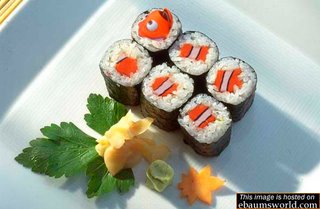
by Kirsten Hawkins
Tempura, sukiyaki, sashimi, sushi – even the words used to describe the most basic of Japanese dishes are exotic and beautiful. Japanese cuisine is easily one of the healthiest in the world, with its concentration on fresh fish, seafood, rice and vegetables. The pungent sauces and delicate flavors of fresh foods complement each other beautifully, and the methods of presentation turn even simple meals into beautiful events.
The Japanese have easily a dozen different names for rice, depending on how it is prepared and what it is served with. The most common meal is a rice bowl, a bowl of white rice served with various toppings or ingredients mixed in. So popular is it that the Rice Bowl has even made its way into the world of Western convenience foods alongside ramen noodles. Domburi is a bowl of rice topped with another food: domburi tendon, for instance, is rice topped with tempura and domburi gyudon is rice topped with beef. The Japanese adopted fried rice from the Chinese, and a century ago, when curry was first introduced, developed Kare Raisu, curry rice. It is now such a popular dish that there are many fast-food restaurants that serve several versions of it in take-away bowls.
Besides white rice served as a side dish, Japanese cuisine also features onigiri – rice balls wrapped in seaweed, often with a ‘surprise’ in the middle, and kayu, a thin gruel made of rice that resembles oatmeal.
As an island nation, it’s not surprising that seafood is featured in Japanese cuisine. Sushi and sashimi both are raw fish and seafood with various spices. Impeccably fresh fish is the secret to wonderful sashimi and sushi, served with wasabi and soya sauce. The Japanese love of beauty and simplicity turns slices and chunks of raw fish into miniature works of art. Fish sliced so thin that it’s transparent may be arranged on a platter in a delicate fan that alternates pink-fleshed salmon with paler slices of fish. Sushi is typically arranged to best display the colors and textures to their best advantage, turning the platter and plate into palettes for the artistry of the chef.
Traditionally, meat plays a minor role in the Japanese diet, though it has been taking a larger and larger role over the past fifty years as Japan becomes more westernized. Beef, chicken and pork may be served with several meals a week now. One of the more popular meat dishes is ‘yakitori’ – chicken grilled on a skewer and served with sauce. A typical quick lunch might include a skewer of yakitori and a rice bowl with sushi sauce.
In an interesting twist, Japan has imported dishes from other cuisines and ‘Japanized’ them, adopting them as part of their own cuisines. Korokke, for instance, are croquettes adopted from those introduced by the English last century. In Japan, the most common filling is a mixture of mashed potatoes and minced meat. Other Soshoyu – western dishes that have made their way into Japanese everyday cuisine include ‘omuraisu’, a rice omelet, and hambagau, the Japanized version of an American hamburger.
About The Author
Kirsten Hawkins is a food and nutrition expert specializing the Mexican, Chinese, and Italian food. Visit http://www.food-and-nutrition.com/ for more information on cooking delicious and healthy meals.http://www.food-and-nutrition.com/ for more information on cooking delicious and healthy meals.
Food and Nutrition.com
Japanese Home Cooking - Beyond Sushi
by Cynthia Bates
In general, the Japanese people are very healthy and live longer than any other culture in the world. Why is this? Many people attribute it to the way they eat. But if you think that all Japanese people eat is sushi you couldn't be more wrong. Japanese home cooking is simple, healthy, and delicious. While some of the ingredients may seem exotic and intimidating, rest assured that anyone can cook wonderful delicious Japanese meals with ease.
Sushi is the most popular type of Japanese food, enjoyed throughout the world. You may notice that sushi is quite filling, and you typically eat much less than you would a more Western style meal, such as a hamburger. What is it about sushi that makes it so filling and satisfying? The answer could be rice.
Rice is definitely a staple of any Japanese meal. Whether it is served as a side dish or along with a saucier entrée, you're going to need plenty of rice on hand. While white long grain rice is most popular, you can always opt for more healthy brown rice. Either way, you may also want to consider purchasing a rice cooker. Rice cookers can cost anywhere from $30 to hundreds of dollars, depending on the make and quality. If you plan on eating plenty of rice this is worth the investment. You're pretty much guaranteed perfect rice every time.
Have you ever had miso soup at your favorite sushi restaurant? Miso soup is made from several ingredients, one of which is miso paste, made from fermented soybeans. Miso comes as either red or yellow, both having distinct and rich flavors. Not just for soup, you can add miso to just about anything from a veggie stir fry to a marinade for beef. And miso isn't just for Japanese cooking either. Once you experience the delightful flavors of miso you'll be adding it to all your meals!
If you dislike fish, you probably think Japanese cooking isn't for you. While fish is definitely a huge part of the Japanese diet, it doesn't mean that's all they eat. Chicken, beef, and pork are all popular choices, as well as tofu and eggs. Simmering meats in sauces such as teriyaki, in a wok or deep skillet is a favorite. You can serve these dishes over rice or noodles such as soba. This is a tasty and healthy alternative to fried foods that many of us eat so often.
If you're interested in Japanese home cooking there are plenty of great recipes on the Internet that can help guide you through the different types of ingredients and cooking methods. If you're looking for a healthy and flavorful change to your diet, consider trying a few Japanese meals. Before you know it you'll be enjoying a variety of delicious foods that nurture the body and the soul.
Copyright
Baking Nation.com
http://www.bakingnation.com
About The AuthorCynthia Bates is an Internet specialist, and periodically writes recipe and cooking articles for http://www.bakingnation.com - BakingNation.com is dedicated to proving quality cooking and recipe discussions on the Internet.
Green Tea - A Tea from the Far East by John Gibb
Green tea is a kind of tea that has been very popular in China and Japan for centuries, and has recently seen a massive explosion in popularity in the West. Its rise is linked in many ways to that of the alternative health movement, which sees green tea as having a range of traditional healing properties and abilities to cure diseases. Although these claims have not been proven, there is documentation for belief in them that goes back over a thousand years.
Some green tea is produced outside China and Japan, but it is mostly considered to be cheap imitations of the 'real thing' and not worth paying attention to, with the possible exception of a few Indian teas. Most green tea drinkers still import their tea from the East, considering this to be the best tea, and some green teas have become especially famous, such as Japanese sencha, and the Chinese teas Longjing, Hou Kui, Piluochun, and many more besides. Although most supermarkets still only stock one form of generic 'green tea', which is usually of very poor quality, health food and herbal shops will generally have a whole range of high-quality, albeit expensive, green teas to choose from.
In Japan, green tea is used as part of a 'tea ceremony', a Buddhist tradition where tea is specially prepared and served to the people present. Participating in the ceremony at all requires intimate knowledge of how it works, meaning that few non-Japanese have ever done so. Tea holds an interesting place in Chinese culture, too, with making tea often being used as a means of non-verbal communication to express sentiments like "I'm sorry" or "thank you". The mythos surrounding tea in Eastern cultures allows the Western green tea drinker to feel that they are taking part in something ancient, traditional and mysterious simply by drinking green tea, and to a certain extent they are.
About the Author
John Gibb is the owner of green tea resources, For more information on green tea please check out http://www.green-tea-guidance.info
Green Tea Guidance.info
Hotels of Japan
 Wedding scene photo by Fuji Film staff
Wedding scene photo by Fuji Film staffJapan offers perhaps the widest range of accommodation in the world. Youth hostels, guest houses, pensions, apartments, ryokan, minshuku, business hotels, hotels and love hotels. Check the JNTO offices outside of Japan and the TIC Offices in Tokyo and Kyoto and the International Centre in Nagoya for the Directory of Welcome Inns. This lists the many foreigner friendly inns in Japan. As well you can see the following website for information about Japanese Ryokan that are used to dealing with foreign tourists: www.jpinn.com
We highly recommend youth hostels. You can buy a Japanese youth hostel membership, then stay very cheaply. There are many youth hostels throughout Japan.
In each town you visit there will be many hotels, business hotels, budget inns and others near the main station. Indeed youth hostels and the cheaper hotels are further away from the station. You can reachthem by bus or train for the most part. The local police box or (koban) are always happy to help if youcan`t find a hotel on your own. Just be sure to be carrying your passport at the time you ask. Just incase they do.
As Japan has such a variety of accommodation, it is a great idea to try them all. Try a ryokan, a minshuku,and even a love hotel if that sounds interesting.
Love Hotels are usually for the purpose of couples getting a little privacy. Something that is lacking in manyJapanese households with often grandma and grandpa living in the same small house. You can also simplyjust stay at one. The prices tend to get lower the later you check in. But best to ask. Sometimes you canget a much more interesting room at a love hotel than at a regular hotel. Some come with a hot-tubbath and elegant decor with many different themes. For a laugh it might be fun to stay in one.
Business Hotels are very cheap hotels usually for businessmen. The rooms are small and sparse. Theyare meant for the single traveller. The rooms are clean and Western style.
Ryokan: For a true Japanese experience you must stay at one at least once while in Japan. Entering theryokan you will take off your shoes, step up and put on some hotel slippers, you can wear these anywhere except in the bathroom (there are bathroom slippers for this purpose), and you cannot walk on tatami mat (reed mat) floors in slippers of any kind.
Your room will be tatami mat and you will sleep on a futon which will magically appear when the made takes it out of the closet and sets it up for you. Your room will have no number but a kanji character usually above the sliding door.
After being shown to your room, drinking tea and eating Japanese style sweets they will ask you to sign the register. Your yukata or robe will have been left and you can then proceed to the bath. For the yukata belt:be sure to wrap the left over the right as the opposite way is for the dead!
You wash yourself outside the bath. After a good scrubbing (of all parts) you rinse off then may enter the bath.After your bath you return to your room to see that dinner has been served. You eat right in your room. This is a very traditional Japanese meal so things that you may feel should be warm, often are not. This is Japan and of course many things, including the food is different.
After dinner you may want to read a book or go for a walk. The maid will clear the food away and set up your futons. In colder weather often a blanket is the first material on you. Westerners often find this strange--preferring a sheet to be the first material to touch their bodies. However, Japanese regard this as being warmer.
In the morning, following a knock at the door, the maid will come in to put away your bedding and serve breakfast.Usually breakfast is served in a different room. Breakfast often consists of cold fish, rice with a raw egg on toporange juice and coffee. This is one meal I have always found difficult to consume in the morning. You may wantto go out for breakfast instead or bring your own. Sometimes Ryokans are understanding and may serve youmorning set if you ask--this is toast, a fried or boiled egg and coffee. If you decline breakfast at the ryokanthey will usually reduce the bill by 10%. You should never decline both dinner and breakfast however. Most ryokan prefer to serve both and charge for both.
Reservations
There is usually a tourist information office at the main train station of each town or city. They can often help with makingreservations for local hotels.
During peak holiday seasons, it is recommended you book your room at least a few days in advance though. But during the offseason, you can usually book a room the sameday or day before.
Atop the Land of the Rising Sun
by Erin Veneziano
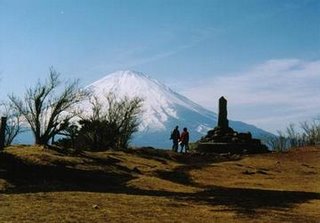 Photo of Ashigara Pass and Mount Fuji by Shawn Thir
Photo of Ashigara Pass and Mount Fuji by Shawn Thir
^To climb Fuji-San once is wisdom; to climb her twice isfoolishness. ̄-Japanese Proverb
Even though most reports claim a severely mundane experience, Fuji-San is still the most trekked mountain in theworld. She is not for those who do not seek wonder and adventure in everyday life. After crossing her timberline there is nothing but a moonscape of barren land and an ostensibly weeping crust of sand and rock.
Most hikers solemnly begrudge her beauty as they drag themselves (as well as their spirits) up her angular trails. Isuppose not too many calculate the sheer absurdity of theiradventure; climbing a dormant (albeit overdue) volcano. This aloneis a source of introspection, doubt, and insecurity.
Looking earthward is not the challenge; but gazing upwardat her looming presence reminds one that the journey is a long wayfrom its conclusion. Her obverse shadow hovers along the cityscapebelow; an ever-present reminder of her majesty and dominance. Eachpassing step falls on a tireless treadmill of self-doubt as long andas varied as kaiten sushi (the conveyor belt kind). ^I am not aperfect mother. ̄ ^I haven¨t donated enough money this year. ̄^I am breathing too much air and someone in Sudan is starving. ̄Of course this list is concluded by, ^I simply know that I cannotfinish. ̄ To conquer Fuji (and all 3,776 meters of her) is to revelin a new birth.
My journey began as a challenge to peak this mountainstarting from the ocean located only meters from my front door. Asthe week progressed and battle plans contrived, the quest waslooking dismal. I would have to leave from work at 10pm, reachGotemba station by one or two in the wee-early hours of the morning,and then sleep like a salary-man (who had one too many) on theconcrete platform and await the rest of my entourage. Needless tosay, this plan was dropped like 7th period French class. Instead wewould start together, at Go-Gome (the 5th station) of the Subashiriroute.The team consisted of two women and myself; a truly mottledgroup of experience and fitness, but certainly unified by the degreeof determination and perseverance possessed. I had been harassingKeiko since the second week of my arrival in Japan, `You have livedhere for 38 years {her entire life} STARING at Fuji-San and haveNEVER climbed up? `. I suppose this was more than a little reminderof her great fortune and luck to be able to see this symbol of Japaneveryday the sky is not opaque with clouds or humidity. Yoshiie onthe other hand had attempted Fuji a fortnight before Keiko hadapproached her, but the mountain denied her access to her hallowedpeak. This time she hadn¨t a doubt in her mind that success wouldbe hers.
^挫並徴謹し ̄^Koji ma Oshi. ̄ ^Good things, many devils. ̄
Fuji-1 Man-0
Upon arriving via bus at Go-Gome we were faced with a decision. Thetyphoon scheduled to have already left Honshu was still whirringaround the central island relentlessly drenching the countryside aswell as anything below 3,000 meters. This included two thirds ofFuji-San. After much deliberation over mushroom tea and someassurance from the mountain staff, we decided to attempt an ascent.If the weather became unbearable (or all out dangerous) we wouldgladly return to shelter below. Others had already re-entered thehut after retreating in all sorts of makeshift rain gear, adultshaving wrapped their boots in duct tape and their children inplastic bags. Our send off was as far from encouraging as one would have hoped.
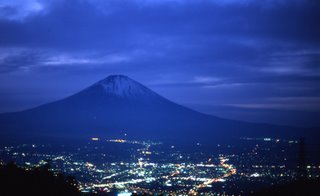
 Photos of Mount Fuji by Fuji Film staff
Photos of Mount Fuji by Fuji Film staff
The sun displayed the trail sparingly, and after a brief stop to pay homage to the Kami (spirits similar to those of the American Indians which are found in everything living and dead) the journey was officially underway. Over the next six hours, we watched the lush green of a highly nourished forest dwindle itself down to smallshrubs; those too eventually acquiescing to rock, sand, and altitude. It was, truly, an insentient and grave sight. An angry wind threw rain as daggers and cut lines of fervor into our faces and any other skin that was exposed to its thrashing. The passing of clouds and windswept debris would often obscure our vision. Time was no longer measured by seconds or minutes (as these were too painful to count), but rather by each successful foot step upward. My companions had fallen silent as they pushed through my wake, and for the first time I had felt alone. I was isolated with my childhood pixies as well as my aging demons.
^鈍・び伊硫き ̄^Nana korobi, ya oki. ̄^To fall seven times, to rise eight times ̄Fuji-2 Man-1
Reaching Hachi-Gome han (Station 8 1/2) was to enter into what fewwould have referred to (audaciously) as a haven, had it not been true that their minds and bodies were reduced to the basic functions of survival. Hotel Fuji can be likened to a beggar¨s corrugated Shangri-la. The roof was held down by basalt boulders (a kind gift from the mountain herself), and the fire inside burned atop tired coals in the small basin-like stove. Our bodies too cold and our stomachs too empty, we sat huddled amongst the other wary travelers hoping to gain heat from the proximity of our bodies. The hut had electricity and (0 coffee to waken our spirits that had been dyingslowly along with the last glowing embers of fire. Here we shed the layers of clothing weighted with sweat and rain and feasted on the heat of our food. Around 8 pm (once the laughter faded to soft and gentle murmurs) we decided to settle into the bunks. Shelves of people lined the room, and sleep evaded all but the old snoringmen. The wake up call was in five hours, and here I lay cramped next to two strangers and trying to share the only warmth I had feltin hours. The only comfort was in knowing that my body was acclimatizing to the altitude and I would have less chance of falling victim to sickness.
^互Xの雑 ̄^Takane no hana ̄^Flower on a high peak ̄Fuji-2 Man-3
She is a wondrous arcane. A temptress. She seduces with a promise of rebirth. To see the sunrise atop her peak is baptism, a weld with the ideal holy. She is her own altar, and the encircling few,are her nimbus. ^Ohayo gozaimasu ̄, a soft summon from our boutswith slumber. It is 1am, and the limp bodies of climbers begin tostir. The amalgamate of roof-rattling wind and creaking bodies forebode more hardship. This time we battle our compatriots for the privilege of the peak at sun break. Gathering our bags, gear and ambition, Yoshiie and I realize we are missing one. Keiko has aslight bout of dehydration, and her head begs for an extra hour ofsleep. There is no argument here. Yoshiie and I wait, drink re-hydrated coffee and babble in each other¨s foreign language. I takea bold step outside and peer at a most perplexing sight. Climbersare lined up, buzzing like anxious fireflies, headlamps poised. Wewill be part of this river of LED lights flowing against the vertical of the climb. I am on the tallest mountain in Japan, and still just one in this mass populace.The drove walked as one; shaking Fuji-san to her molten core. The altitude would halt the crowd and the air would wheeze in and thenoff the mountain. The top was an hour and a half away, and sunrisecreeping ever closer to that estimate. Sorry travelers that hadbeen going since early night would break formation and stumble aside. Some, more obvious than others, were suffering the effects of altitude. Occasionally you could hear the huffing of canned oxygen over the crushing of cinder.I made the decision. We would stop at a rocky outcropping and await the moment we had been working so hard to achieve. The typhoon left a still evening in its wake. This was the magic of lore, a crystalline sky gleaming with stars whispering the history of theuniverse in their shimmer. My grin occupied the void where words were meaningless to the sight at hand. The city below and hergentle intermittent glow were partially covered like a sleepingchild in a blanket of pillowed clouds. Fuji was dimpling the patchwork of night with her cumbrous silhouette; and I was still.The schism between reality and dream dissipated into ephemeral euphoria.
The battle with cold had not yet abated and our perch gave the voracious morning gusts (at this height the wind is almost always agust or in constant gales) exposed flesh upon which to feast. We huddled our bodies to keep warm and chatted our thoughts to feed ourown appetitive excitement. As typical Japanese clockwork, the sundid not make us wait past her due. We were witness to the emptyhorizon filling with deep chartreuse, warming itself into gentle ocher before giving way to the day¨s first rays and the emerging ocean of blues. To say there was a standing ovation would bediscrediting. Fuji-san was awoken from her slumber with the brazencries of, ^BANZAI!!!! ̄ She was alive, and we too, were breathingin a new day.
^No spot in this world can be more horrible, more atrociouslydismal, than the cindered tip of the Lotus as you stand upon it. ̄-Lafcadio HernFuji Б 3 Man-4
There is nothing more abrading than an overly enthusiastic tourguide harping, `The top is only 20 steps away, GAMBATTE (keepfighting)!`. I can see the Torii Gate, a simple earthen entrance made of senescent lumber; a distinctly humble welcome for those whohave endured. Keiko and Yoshiie are standing a few steps behind me and I wait to cross the threshold beside, and with them. I cannothelp but kiss the wrinkled gates as I pass through, pushed by the heaving mass behind me. Glory, like clement weather, is short lived here. The gales, unabated, fiercely grip all and for most (ourselvesincluded) the peak is enjoyed not as one would a vintage wine, butrather as a can of coke taken from one of the many vending machines that environ the crater. Our stay is brief.
We take a few moments to enjoy our breakfast of energy gels,granola, onigiri (rice balls) and of course a celebratory 4-ouncecan of Asahi Super dry. Keiko proclaimed this to be the mostexpensive beer she had ever had (thus I tried to charge her for it),and Yoshiie called it a gift from the Gods. We had balcony seats towatch the lives of hundreds of thousands play out before us on a seemingly miniature scale. For once, the three of us were bigger than the insensate lives we so commonly lead. Along the crater rim there is a path cut from the circumambulation of many ascetics. Fuji-san has inspired an entire religion; other than the throngs of the awe inspired. Juxtapose to where we sitthere is the weather station defiant and opposing atop Fuji`s truepeak. To reach this we must add another 2 hours of wear to ourdusted boots, but the soles have already been thinned. My groupdecides only to visit the shrine, already laden with bells toappease the capricious spirits. Yoshiie adds one more chime to theamassed pile, and all three of us append prayers to the opulent Torii. A few triumphant pictures and hurriedly past the touristtraps (including a post office) and the descent begins. They callit a ^sand slide ̄ , in no way a misnomer of the mirage we standbefore. .
^彭凛寄蕉 ̄^Chakugan taikyoku ̄^To see and understand the great situation. ̄
Fuji Б4 Man-4
With declines hovering around 45%, the descent was a challenge all unto itself. If ever there was a chance to believe in zero gravity whilst being earthbound, this was it. A single step, a bound, could carry you down slope 3 meters. An astronaut; a snowboarder; a diver; a water walker; my imagination afloat on the crescendo of sand below my feet. I couldn¨t help but leave my partners behind in my over zealous jaunt. I should have been wearing a helmet toward off the occasionally boulder, protruding bravely and fighting for its integrity or maybe an ounce of sun. I believe I was playinga game of tag that had already been deemed finished (and decidedlyso). The mountain eventually took the wind from my sails, and my knees fell like the mast of my imagination. I wanted down. Keikoand Yoshiie wanted down. Five hours of meandering down the oxbowtrails and we finished. Having stripped ourselves of the fustianouter layers and all inane conversation, we sat quieted by theimplausible value of our labor. Fuji had taken us through thespectrum of emotion, emblazoning the prism within our memories andhearts.
You never conquer her. Rather, Fuji-san always conquers you. Thereis death atop Fuji. As falling leaves, doubt and fear desiccate anddrop away. The colors of the human spirit change, and for this Fuji-san is in perpetual fall.
Discover Mount Fuji - Views from the Top of Japan
by Hige Sori
Mount Fuji, or as the Japanese call it - Fujisan, is a dormant volcano and the highest peak in Japan. Sometimes referred to incorrectly in the West as Fujiyama, Mount Fuji is Japan's most famous mountain and a cultural icon. Throughout Japanese history Mt Fuji features heavily and one of the most famous depictions of the almost sacred mountain is the "36 Views of Mount Fuji" series of ukiyo-e woodblock prints by Katsushika Hokusai (1760-1849).
Some quick facts about Mt Fuji include that it is 3776 metres (12290 feet) high, approximately 161km (100 miles) south-west of Tokyo and that the last eruption of Mount Fuji was about 300 years ago, in 1707.
The busiest time to visit the mountain is July, when with Japanese schools have their holidays, however about a third of all climbers are foreigners. The snow capped pinnacle can quite treacherous outside of these months with freezing temperatures, avalanches and strong winds. When the snow melts in warmer weather it more resembles a lunar landscape covered with black volcanic rock.
Although many people have seen the well known photograph of Mount Fuji with the shinkansen bullet train barrelling through the fields in the foreground, perhaps the easiest and best way to get to Mt Fuji from Tokyo is by bus which only takes a few hours. The highway bus departs from Shinjuku station, however you may need to change buses at Kawaguchiko station. The official climbing season runs from July to August and crowds of young and old make the ascent each day. During this period there are around 15 buses each day leaving from Shinjuku in Tokyo. At other times transport can be limited and climbing Mt Fuji is not recommended anyway.
Even in the summer high season it is important you prepare for climbing Mt Fuji properly. Climbing experience is not required and you will see many small children and elderly folk along the way. Good study shoes, some water and energy snacks are a must, along with a raincoat, torch, hat and warm clothing if you intend to hike at night. Even in the warmer months the temperatures at the top can drop to around 6°C (43°F). If you are unsure about heights you may want to consider picking up some altitude sickness tablets and even some 'canned' oxygen which is available for purchase on the mountain or beforehand from stores in Tokyo like Shinjuku's Tokyu Hands.
The way up is divided into 10 stations or checkpoints. Generally visitors elect to start climbing about halfway up Mount Fuji on the Kawaguchiko trail at station 5. They arrive by bus or car and the climb takes around 7 hours to reach the summit and then another 4 to get back down again. The round trip can be completed in a very long day. Many people choose to begin their trek at nightfall and time it so they and arrive at the peak at dawn.
During July and August there are huts, toilet facilities and food stops open on the mountain in case you need to rest or take some time-out. But be warned, they can be rather pricy and a bit primitive so make sure to take a bit of cash with you too.
There is a famous Japanese saying that goes -- "You are a fool if you don't climb Mount Fuji, you are also a fool if you climb it twice."
On a clear day seeing the sunrise from this highest point in Japan is quite a breath taking spectacle and is sure to be the highlight of your sightseeing in Japan. It's definitely a worthy side trip from Tokyo and the view from the top of Mount Fuji will be forever be etched in you mind. This is one experience that you do not want to miss on your visit to the land of the Rising Sun.
About the Author
Hige Sori is the editor of Tokyo, Japan... Tokyo! Want to learn more to help you live in, work in or travel Japan? Read more now at -- TokyoJapanTokyo.com
Tokyo, Japan...Tokyo!
Learn more about living and working in Japan at our Japan Living Forum.
 Photo of Ashigara Pass and Mount Fuji by Shawn Thir
Photo of Ashigara Pass and Mount Fuji by Shawn Thir^To climb Fuji-San once is wisdom; to climb her twice isfoolishness. ̄-Japanese Proverb
Even though most reports claim a severely mundane experience, Fuji-San is still the most trekked mountain in theworld. She is not for those who do not seek wonder and adventure in everyday life. After crossing her timberline there is nothing but a moonscape of barren land and an ostensibly weeping crust of sand and rock.
Most hikers solemnly begrudge her beauty as they drag themselves (as well as their spirits) up her angular trails. Isuppose not too many calculate the sheer absurdity of theiradventure; climbing a dormant (albeit overdue) volcano. This aloneis a source of introspection, doubt, and insecurity.
Looking earthward is not the challenge; but gazing upwardat her looming presence reminds one that the journey is a long wayfrom its conclusion. Her obverse shadow hovers along the cityscapebelow; an ever-present reminder of her majesty and dominance. Eachpassing step falls on a tireless treadmill of self-doubt as long andas varied as kaiten sushi (the conveyor belt kind). ^I am not aperfect mother. ̄ ^I haven¨t donated enough money this year. ̄^I am breathing too much air and someone in Sudan is starving. ̄Of course this list is concluded by, ^I simply know that I cannotfinish. ̄ To conquer Fuji (and all 3,776 meters of her) is to revelin a new birth.
My journey began as a challenge to peak this mountainstarting from the ocean located only meters from my front door. Asthe week progressed and battle plans contrived, the quest waslooking dismal. I would have to leave from work at 10pm, reachGotemba station by one or two in the wee-early hours of the morning,and then sleep like a salary-man (who had one too many) on theconcrete platform and await the rest of my entourage. Needless tosay, this plan was dropped like 7th period French class. Instead wewould start together, at Go-Gome (the 5th station) of the Subashiriroute.The team consisted of two women and myself; a truly mottledgroup of experience and fitness, but certainly unified by the degreeof determination and perseverance possessed. I had been harassingKeiko since the second week of my arrival in Japan, `You have livedhere for 38 years {her entire life} STARING at Fuji-San and haveNEVER climbed up? `. I suppose this was more than a little reminderof her great fortune and luck to be able to see this symbol of Japaneveryday the sky is not opaque with clouds or humidity. Yoshiie onthe other hand had attempted Fuji a fortnight before Keiko hadapproached her, but the mountain denied her access to her hallowedpeak. This time she hadn¨t a doubt in her mind that success wouldbe hers.
^挫並徴謹し ̄^Koji ma Oshi. ̄ ^Good things, many devils. ̄
Fuji-1 Man-0
Upon arriving via bus at Go-Gome we were faced with a decision. Thetyphoon scheduled to have already left Honshu was still whirringaround the central island relentlessly drenching the countryside aswell as anything below 3,000 meters. This included two thirds ofFuji-San. After much deliberation over mushroom tea and someassurance from the mountain staff, we decided to attempt an ascent.If the weather became unbearable (or all out dangerous) we wouldgladly return to shelter below. Others had already re-entered thehut after retreating in all sorts of makeshift rain gear, adultshaving wrapped their boots in duct tape and their children inplastic bags. Our send off was as far from encouraging as one would have hoped.

 Photos of Mount Fuji by Fuji Film staff
Photos of Mount Fuji by Fuji Film staffThe sun displayed the trail sparingly, and after a brief stop to pay homage to the Kami (spirits similar to those of the American Indians which are found in everything living and dead) the journey was officially underway. Over the next six hours, we watched the lush green of a highly nourished forest dwindle itself down to smallshrubs; those too eventually acquiescing to rock, sand, and altitude. It was, truly, an insentient and grave sight. An angry wind threw rain as daggers and cut lines of fervor into our faces and any other skin that was exposed to its thrashing. The passing of clouds and windswept debris would often obscure our vision. Time was no longer measured by seconds or minutes (as these were too painful to count), but rather by each successful foot step upward. My companions had fallen silent as they pushed through my wake, and for the first time I had felt alone. I was isolated with my childhood pixies as well as my aging demons.
^鈍・び伊硫き ̄^Nana korobi, ya oki. ̄^To fall seven times, to rise eight times ̄Fuji-2 Man-1
Reaching Hachi-Gome han (Station 8 1/2) was to enter into what fewwould have referred to (audaciously) as a haven, had it not been true that their minds and bodies were reduced to the basic functions of survival. Hotel Fuji can be likened to a beggar¨s corrugated Shangri-la. The roof was held down by basalt boulders (a kind gift from the mountain herself), and the fire inside burned atop tired coals in the small basin-like stove. Our bodies too cold and our stomachs too empty, we sat huddled amongst the other wary travelers hoping to gain heat from the proximity of our bodies. The hut had electricity and (0 coffee to waken our spirits that had been dyingslowly along with the last glowing embers of fire. Here we shed the layers of clothing weighted with sweat and rain and feasted on the heat of our food. Around 8 pm (once the laughter faded to soft and gentle murmurs) we decided to settle into the bunks. Shelves of people lined the room, and sleep evaded all but the old snoringmen. The wake up call was in five hours, and here I lay cramped next to two strangers and trying to share the only warmth I had feltin hours. The only comfort was in knowing that my body was acclimatizing to the altitude and I would have less chance of falling victim to sickness.
^互Xの雑 ̄^Takane no hana ̄^Flower on a high peak ̄Fuji-2 Man-3
She is a wondrous arcane. A temptress. She seduces with a promise of rebirth. To see the sunrise atop her peak is baptism, a weld with the ideal holy. She is her own altar, and the encircling few,are her nimbus. ^Ohayo gozaimasu ̄, a soft summon from our boutswith slumber. It is 1am, and the limp bodies of climbers begin tostir. The amalgamate of roof-rattling wind and creaking bodies forebode more hardship. This time we battle our compatriots for the privilege of the peak at sun break. Gathering our bags, gear and ambition, Yoshiie and I realize we are missing one. Keiko has aslight bout of dehydration, and her head begs for an extra hour ofsleep. There is no argument here. Yoshiie and I wait, drink re-hydrated coffee and babble in each other¨s foreign language. I takea bold step outside and peer at a most perplexing sight. Climbersare lined up, buzzing like anxious fireflies, headlamps poised. Wewill be part of this river of LED lights flowing against the vertical of the climb. I am on the tallest mountain in Japan, and still just one in this mass populace.The drove walked as one; shaking Fuji-san to her molten core. The altitude would halt the crowd and the air would wheeze in and thenoff the mountain. The top was an hour and a half away, and sunrisecreeping ever closer to that estimate. Sorry travelers that hadbeen going since early night would break formation and stumble aside. Some, more obvious than others, were suffering the effects of altitude. Occasionally you could hear the huffing of canned oxygen over the crushing of cinder.I made the decision. We would stop at a rocky outcropping and await the moment we had been working so hard to achieve. The typhoon left a still evening in its wake. This was the magic of lore, a crystalline sky gleaming with stars whispering the history of theuniverse in their shimmer. My grin occupied the void where words were meaningless to the sight at hand. The city below and hergentle intermittent glow were partially covered like a sleepingchild in a blanket of pillowed clouds. Fuji was dimpling the patchwork of night with her cumbrous silhouette; and I was still.The schism between reality and dream dissipated into ephemeral euphoria.
The battle with cold had not yet abated and our perch gave the voracious morning gusts (at this height the wind is almost always agust or in constant gales) exposed flesh upon which to feast. We huddled our bodies to keep warm and chatted our thoughts to feed ourown appetitive excitement. As typical Japanese clockwork, the sundid not make us wait past her due. We were witness to the emptyhorizon filling with deep chartreuse, warming itself into gentle ocher before giving way to the day¨s first rays and the emerging ocean of blues. To say there was a standing ovation would bediscrediting. Fuji-san was awoken from her slumber with the brazencries of, ^BANZAI!!!! ̄ She was alive, and we too, were breathingin a new day.
^No spot in this world can be more horrible, more atrociouslydismal, than the cindered tip of the Lotus as you stand upon it. ̄-Lafcadio HernFuji Б 3 Man-4
There is nothing more abrading than an overly enthusiastic tourguide harping, `The top is only 20 steps away, GAMBATTE (keepfighting)!`. I can see the Torii Gate, a simple earthen entrance made of senescent lumber; a distinctly humble welcome for those whohave endured. Keiko and Yoshiie are standing a few steps behind me and I wait to cross the threshold beside, and with them. I cannothelp but kiss the wrinkled gates as I pass through, pushed by the heaving mass behind me. Glory, like clement weather, is short lived here. The gales, unabated, fiercely grip all and for most (ourselvesincluded) the peak is enjoyed not as one would a vintage wine, butrather as a can of coke taken from one of the many vending machines that environ the crater. Our stay is brief.
We take a few moments to enjoy our breakfast of energy gels,granola, onigiri (rice balls) and of course a celebratory 4-ouncecan of Asahi Super dry. Keiko proclaimed this to be the mostexpensive beer she had ever had (thus I tried to charge her for it),and Yoshiie called it a gift from the Gods. We had balcony seats towatch the lives of hundreds of thousands play out before us on a seemingly miniature scale. For once, the three of us were bigger than the insensate lives we so commonly lead. Along the crater rim there is a path cut from the circumambulation of many ascetics. Fuji-san has inspired an entire religion; other than the throngs of the awe inspired. Juxtapose to where we sitthere is the weather station defiant and opposing atop Fuji`s truepeak. To reach this we must add another 2 hours of wear to ourdusted boots, but the soles have already been thinned. My groupdecides only to visit the shrine, already laden with bells toappease the capricious spirits. Yoshiie adds one more chime to theamassed pile, and all three of us append prayers to the opulent Torii. A few triumphant pictures and hurriedly past the touristtraps (including a post office) and the descent begins. They callit a ^sand slide ̄ , in no way a misnomer of the mirage we standbefore. .
^彭凛寄蕉 ̄^Chakugan taikyoku ̄^To see and understand the great situation. ̄
Fuji Б4 Man-4
With declines hovering around 45%, the descent was a challenge all unto itself. If ever there was a chance to believe in zero gravity whilst being earthbound, this was it. A single step, a bound, could carry you down slope 3 meters. An astronaut; a snowboarder; a diver; a water walker; my imagination afloat on the crescendo of sand below my feet. I couldn¨t help but leave my partners behind in my over zealous jaunt. I should have been wearing a helmet toward off the occasionally boulder, protruding bravely and fighting for its integrity or maybe an ounce of sun. I believe I was playinga game of tag that had already been deemed finished (and decidedlyso). The mountain eventually took the wind from my sails, and my knees fell like the mast of my imagination. I wanted down. Keikoand Yoshiie wanted down. Five hours of meandering down the oxbowtrails and we finished. Having stripped ourselves of the fustianouter layers and all inane conversation, we sat quieted by theimplausible value of our labor. Fuji had taken us through thespectrum of emotion, emblazoning the prism within our memories andhearts.
You never conquer her. Rather, Fuji-san always conquers you. Thereis death atop Fuji. As falling leaves, doubt and fear desiccate anddrop away. The colors of the human spirit change, and for this Fuji-san is in perpetual fall.
Discover Mount Fuji - Views from the Top of Japan
by Hige Sori
Mount Fuji, or as the Japanese call it - Fujisan, is a dormant volcano and the highest peak in Japan. Sometimes referred to incorrectly in the West as Fujiyama, Mount Fuji is Japan's most famous mountain and a cultural icon. Throughout Japanese history Mt Fuji features heavily and one of the most famous depictions of the almost sacred mountain is the "36 Views of Mount Fuji" series of ukiyo-e woodblock prints by Katsushika Hokusai (1760-1849).
Some quick facts about Mt Fuji include that it is 3776 metres (12290 feet) high, approximately 161km (100 miles) south-west of Tokyo and that the last eruption of Mount Fuji was about 300 years ago, in 1707.
The busiest time to visit the mountain is July, when with Japanese schools have their holidays, however about a third of all climbers are foreigners. The snow capped pinnacle can quite treacherous outside of these months with freezing temperatures, avalanches and strong winds. When the snow melts in warmer weather it more resembles a lunar landscape covered with black volcanic rock.
Although many people have seen the well known photograph of Mount Fuji with the shinkansen bullet train barrelling through the fields in the foreground, perhaps the easiest and best way to get to Mt Fuji from Tokyo is by bus which only takes a few hours. The highway bus departs from Shinjuku station, however you may need to change buses at Kawaguchiko station. The official climbing season runs from July to August and crowds of young and old make the ascent each day. During this period there are around 15 buses each day leaving from Shinjuku in Tokyo. At other times transport can be limited and climbing Mt Fuji is not recommended anyway.
Even in the summer high season it is important you prepare for climbing Mt Fuji properly. Climbing experience is not required and you will see many small children and elderly folk along the way. Good study shoes, some water and energy snacks are a must, along with a raincoat, torch, hat and warm clothing if you intend to hike at night. Even in the warmer months the temperatures at the top can drop to around 6°C (43°F). If you are unsure about heights you may want to consider picking up some altitude sickness tablets and even some 'canned' oxygen which is available for purchase on the mountain or beforehand from stores in Tokyo like Shinjuku's Tokyu Hands.
The way up is divided into 10 stations or checkpoints. Generally visitors elect to start climbing about halfway up Mount Fuji on the Kawaguchiko trail at station 5. They arrive by bus or car and the climb takes around 7 hours to reach the summit and then another 4 to get back down again. The round trip can be completed in a very long day. Many people choose to begin their trek at nightfall and time it so they and arrive at the peak at dawn.
During July and August there are huts, toilet facilities and food stops open on the mountain in case you need to rest or take some time-out. But be warned, they can be rather pricy and a bit primitive so make sure to take a bit of cash with you too.
There is a famous Japanese saying that goes -- "You are a fool if you don't climb Mount Fuji, you are also a fool if you climb it twice."
On a clear day seeing the sunrise from this highest point in Japan is quite a breath taking spectacle and is sure to be the highlight of your sightseeing in Japan. It's definitely a worthy side trip from Tokyo and the view from the top of Mount Fuji will be forever be etched in you mind. This is one experience that you do not want to miss on your visit to the land of the Rising Sun.
About the Author
Hige Sori is the editor of Tokyo, Japan... Tokyo! Want to learn more to help you live in, work in or travel Japan? Read more now at -- TokyoJapanTokyo.com
Tokyo, Japan...Tokyo!
Learn more about living and working in Japan at our Japan Living Forum.
Guide to Kamakura
 Photo (left) by Ikumi Kishiya
Photo (left) by Ikumi Kishiya Photo (above) by Fuji Film staff
Photo (above) by Fuji Film staffKamakura, Kanagawa Prefecture
(From Tokyo take the Yokosuka Line from Tokyo, Shimbashi and Shinagawa Stations approx. 1 hr)
"The capital of Japan from 1185 to 1333, Kamakura rivals Nikko as the most culturally rewarding day trip from Tokyo. There are a huge number of Buddhist temples and the occasional shrine dotted around the surrounding countryside, as well as some very pleasant walks." --Japan, Lonely Planet
I highly recommend this gem of the Shonan coast as one of the must see places in Japan. When deciding to write this guide, Kamakura was one of the first places after Kyoto I decided I would list. John Carroll`s, Trails of Two Cities (Kodansha International, 1997) is a good guide to the city and surrounding area. An area full of flowers all year round.
Kamakura has three main areas: Kita-Kamakura, the Great Buddha area, and Central Kamakura.The quietest, most scenic and most meditative is Kita-Kamakura (or North Kamakura). It is best to visit the city on a weekday as weekends tend to be very crowded.
Kita-Kamakura
Engaku-ji Founded: 1282 The entrance to the temple is near Kita-Kamakura Station.Built to comfort the souls of the warriors slain in the great Mongol invasion the previous year..If you go up the stone stairs to the right, you will see the Great Bell. It is famous for it`s beautifulsound and shape. Take some time to have some tea and contemplate life at one of the many subtemplessurrounding the main temple.
Kencho-jiFounded: 1253 The walkway to the Buddha Hall or (Butsuden) is lined with 700 year old junipers--wellworth seeing themselves. To the left behind the main temple is a famous pond garden reputedly made byMuso Soseki. The path continues into the hills and you can engage in some hiking if you`d like. The hikingaround Kamakura is very good.
Central Kamakura
 Photo of Kamakura Street by Ikumi Kishiya
Photo of Kamakura Street by Ikumi KishiyaTsurugaoka Hachiman-gu (Exit East Side of Kamakura Station)
Then it is ten minutes walk on foot. Walk along Wakamiya-oji Street which has three large gates so itis difficult to get lost. Part of the street is lined with cherry trees and is beautiful in the spring.This is the main shrine of Kamakura. Founded by Minamoto Yoriyoshi whose clan rules Japan from Kamakura.The central entrance crosses a bridge over a lotus leaf pond called Gempei Ike. On the left of the ShrineHall or (Hongu) is a one thousand year old gingko tree. Sanetomo was assassinated by his nephew who leaped from behind the tree in 1219.
Japanese Language Point:Doko desuka?=Where is? (the `o` is hard not soft)If you get lost just ask one of the locals:"Tsurugaoka Hachiman-gu doko desuka?" Surugowka hochymon doko des ka?This is: "Where is Tsurugaoka Hachiman-gu?"
Kamakura`s Great Buddha Area
Daibatsu (The Great Buddha)
The Daibatsu or Great Bussha is one of the most enduring images of Japan. Indeed it is Kamakura`s most famoussight. It was built in 1252. It was once housed indoors but now sits outside guarding over the city. The statue is11.4 metres tall. It is artistically superior to the Nara Buddha, though smaller.
"Once housed in a huge hall, the statue today sits in the open, its home having been washed away by a tsunami in 1495. Cast in bronze and weighing closeto 850 tonnes, the statue is 11.4 m tall. Its construction is said to have been inspired by Yoritomo`s visit to Nara (where there is another, even bigger, daibutsu) after the Minamoto clanPs victory over the rival Taira clan. Even though Kamakura`s Daibatsu doesn`t match Nara`s in stature, it is commonly agreed that it is artistically superior."--Japan, Lonely Planet
Hase-dera (5 minutes from Hase Station on the Enoden Line)
This temple has a 9 meter tall gilded image of Kannon. This Kannon was carved from one gigantic camphor tree.The grounds are filled with many stone jizo dressed in red. These are to comfort the unborn children. (There are many abortions in Japan.)
"By legend, this temple`s 9 meter-tall gilded image of Kannon was carved from the sameimmense camphor tree as the celebrated Hase-kannon in the mountains south of Nara.The twin was set adrift and eventually washed ashore at Kamakura in 736, where this temple was founded for it."--June Kinoshia & Nicholas Palevsky, Gateway to Japan
There are many more temples in Kamakura than are listed here. However these are the must sees in my opinion.
 Classic photo of a bridge in Kamakura
Classic photo of a bridge in Kamakura
Yokohama Sights
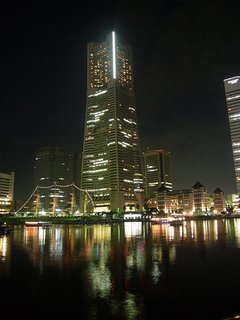
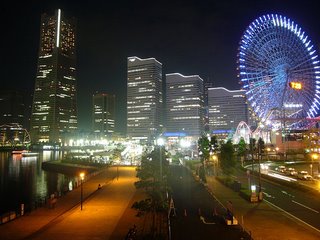
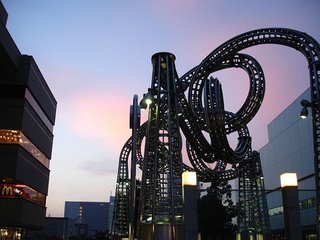 Photos of Sakuragicho, Yokohama, by Norikazu Yamaguchi
Photos of Sakuragicho, Yokohama, by Norikazu YamaguchiYokohama
Population: 3.5 Million 30 Minutes by Tokaido Line Train from Tokyo
Yokohama is Japan`s second largest city. She is one of Japan`s most beautiful. In many places one can imagine they are in Vancouver or Seattle. One of the Yokohama sights Minato Mirai 21 looks very much like parts of Vancouver, one of Yokohama`s sister cities.
Yokohama Sights
While Yokohama is very nice and I enjoy going there myself, if you only have two weeks in Japan it might be better to journey elsewhere. If you come to live in the Kanto area of Japan, you must visit Yokohama. If not then read on and decide for yourself whether it is worth seeing a North American looking city in Japan.
Yokohama Station Area (Tokaido Line and others)
An area for shopping.
Minato Mirai 21 -- Sakuragicho
"The Minato Mirai 21 district on the waterfront is highly popular among (the) younger generation, offering a most enjoyable shopping and fantasic gourmet experience."--Your Guide to Japan, JNTO
This area reminds me so much of Vancouver I get homesick! It is very nice and the modern buildings are beautiful.There are many great restaurants as the above quote suggests, and the shopping is also interesting. Minato Mirai21 is a very futuristic looking part of the city.
Landmark Tower is the anchor of this modern area and the tallest building in Japan. Across the street is the Yokohama Maritime Museum and the tallship Nippon Maru. Nearby is the Cosmo World Amusement Park.Near Cosmo World is Yokohama World Porters shopping complex and Queen`s Square Yokohama, both boastmany shops and restaurants.
Yamashita Park (East of Kannai Station)
This is another area of harbour front that offers nice views of the sea and the ships. The retired liner Hikawa Maru is worth going on if you have children. My parents claim the nearby Silk Museum is a must see. But Ihave never been so as you can imagine, I never listen to them! Apparently seeing thesilk worms working their magic is an amazing sight!
Chinatown
Not a living breathing Chinatown like you would find in San Francisco or Vancouver, but an area with many great restaurants and a few Chinese employees working there. You rarely hear Chinese spoken on the street here as you would in Chinatowns in the above mentioned cities. The food is great and it is interesting area to walk around though.
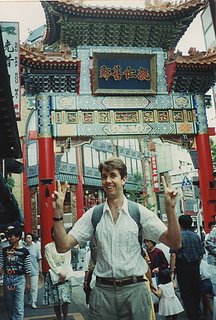 Photo of Chinatown gate by Ikumi Kishiya
Photo of Chinatown gate by Ikumi Kishiya"This is one of Yokohama`s greatest tourist attractions and the tiny streets are often packed with visitors who come to ogle the over-the-top Chinese facades of the neighbourhood`s stores and restaurants. Needless to say, food is the main attraction here, but be warned that prices are high."--Japan, Lonely Planet
Sankei-en Garden
Established: 1906A 500 year old pagoda rests amongst a beautiful garden. Take the No. 8 bus from Yokohama or Sakuragi-chostations to Honmoku Sankei-en-Mae bus stop.
Shin-Yokohama Station Area
Shin-Yokohama Ramen Museum: Has a replica of the downtown area of a Japanese city around 1958 with various ramen (Chinese noodle) restaurants. Some of the best ramen cooks in Japan make their best in this museum. Go East from Shin-Yokohama station (5 minutes).
Nightlife
Check out the many bars on the edge of Chinatown in the evening.
Transportation
You can get to or from Narita by train or bus. The Narita Express Train is a convenient and comfortable way to get to or from the airport.
Within Yokohama:Trains are probably the most convenient, though not as convenient as in Tokyo. There is also an extensive bus network and you just pay a small flat fee.
The Sea Bass (Sea Bus)Runs between Yokohama Station, Minato Mirai 21, and Yamashita Park. Yokohama Station toYamashita Park takes 20 minutes.
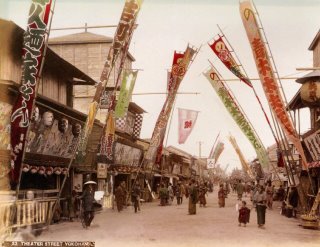 Old Yokohama, what it must have looked like in the 19th
Old Yokohama, what it must have looked like in the 19thcentury
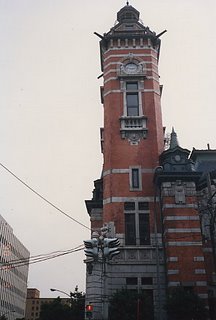 Photo of Yokohama clock tower by Kevin Burns
Photo of Yokohama clock tower by Kevin BurnsFor more information about living and working in Yokohama, join the Living in Yokohama Forum.
Tokyo Open Air Architectural Museum
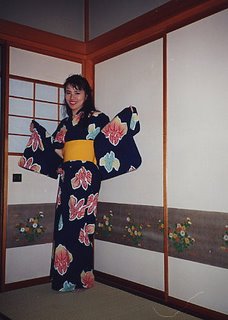
Edo-Tokyo Tatemono-en/The Edo-Tokyo Open Air Architectural Museum
Tokyo
"Does spending a day with you family `walking through history,` sitting on tatmi mats around glowing hearths of wooden farmhouses, imagining sounds of lively bathing in old sento, and tasting old fashioned treats at old fashioned prices sound appealing? The Edo-Tokyo Tatemono-en (Open Air Architectural Museum) is a little known gem in Tokyo just waiting to provide your family with such a memorable Japanese experience." --Valerie Sawatzky, Edo-Tokyo, Tatemono-en, Tokyo Families Magazine
Located in Koganei Park is this very interesting museum devoted to giving you an opportunity to sense history by bringing buildings important to their time period together in one place. The buildings are well preserved and placed realistically throughout the park.
With English signs throughout the park it is easy to navigate. Enjoy the crackling of braziers and watch your children frolic in some of the 200 year old farmhouse sprinkled in the rural setting.
Beautiful old homes of the pre-World War 2 era are on view as well. These were homes owned by the well to do, the merchant class and other professionals. My children enjoyed exploring the storerooms and the rest of the houses. My wife and I found it interesting to see how Western and Japanese influences mixed throughout the buildings,including the choices of furniture.
If you are feeling a tad peckish after viewing the homes, you can stop for a bite in a traditional tea house. Reasonably priced Japanese dishes can be ordered including donburi and soba.
Finally enjoy the old Tokyo downtown street scene or (shitamachi in Japanese. It includes a streetcar, bathhouse, policestation, stores and other buildings. Street sellers in yukata sell treats all along the street, and their are old fashioned games in the square for the kids.
Take a break from the hustle and bustle of this huge city and get a sense of what life was like many years ago when life was simpler.
Edo-Tokyo Tatemono En3-7-1 Sakura ChoKoganei City Tokyo Telephone: 0423-88-311 Closed on Mondays
How to get there? From Seibu Shinjuku Line`s Hanakoganei Station, it is 5 minutes by any bus from the Seiyu Store. Get off at Koganei Nishiguchi (West Entrance to Koganei Park)
Bibliography
Sawatzky, Valerie, Edo-Tokyo, Tatemono-en, Tokyo Families Magazine
An excellent article detailing this park.
Tokyo Sights, Things to Do
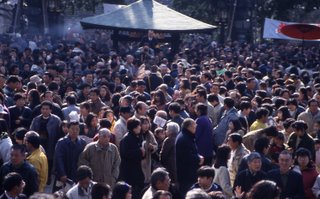
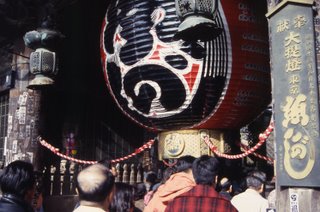
Asakusa
Pictured: Asakusa Gong, and Asakusa Street scene, courtesy of Fuji Film Staff
"Centered around Sensoji Temple with a history of 1,400 Years, the Asakusa district represents Tokyo`s old downtown, steeped in the nostalgic atmosphere of Edo-period while retaining a variety of traditional arts and crafts. The narrow streets leading to the temple are called "Nakamise" and are lined with colorful shops and stalls. Thronged with temple visitors and tourists year round, the "Nakamise" area comes especially alive during the festival season. Asakusa is truly enjoyable -- for delights of the palate at long-established restaurants, for strolling along side streets, and much more. Come visit Asakusa, and experience the centuries -old nostalgia of long ago Tokyo."--Oohisa, Iizumi, Tokyo Metropolitan S.G.G Club
It`s an interesting area that can be explored on foot. It is one of the few areas of Tokyo that has retained its feeling of history. A walk to Senso-ji (temple) can give one a glimpse of what Tokyo must have been like many years ago.
In Senso-ji one can see the Buddhist Goddess of Mercy, which according to legend wasrescued from the Sumida River in 628 AD. You can get to the temple from Asakusa SubwayStation. On Nakamise Street you can find Edo style crafts. Edo was one of the significant eras of Japanese history preceding the Meiji era. Edo was also the old name of Tokyo and the era was named Edo because of Tokyo`s preeminence at that time--and of course her preeminence continues today.
Sumida River Cruise
It is an interesting cruise if not the most picturesque. My wife and I enjoyed it and felt we understood Tokyo better from doing it. The cruise leaves from next to Azuma Bridge in Asakusa and goes to Hamarikyu-teien and Hinode Pier. If you go to the former,you can see a lovely garden for a smalll fee. After seeing the garden you can walk around Ginza which is an interesting shopping area.
Akihabara
If you are interested in electronic toys and gizmos then you really must visit Akihabara. If you aren`t then you don`t need to go here. Tourist frequent the area looking to buy things not available at home or to see the amazing variety of electronic goods all in one area. In contract to many cities in North America, Akihabara is like a city of electronics stores. Side by side you can visit store after store, selling everything from TVs, portable stereos, video and computer games to anything imaginable thatruns on electric current. You can ask for duty free items and there are many stores that cater solely to duty free buyers. Take the Electric Town exit from Akihabara Station (Yamanote Line). Be sure to bargain, you can sometimes get a discount. No where else in the world will you find the range of products you can find in Akihabara and you can literally spend the day here. I have!
Ueno
The only reason perhaps to visit Ueno unless you live in Tokyo is for the museums. I enjoy it myself for shopping and just walking around, but as a tourist, unless you are a museum buff, I wouldn`t bother going to the area. The movie "The Last Samurai," was perhaps based on an incident that occurred in Ueno Park, the last ditch battle by 2000 of Tokugawa`s Samurai versus The Imperial Army.
The museums of Japan are generally much smaller than in Western countries. They tend to be more specialized too. The Tokyo National Museum Tel. 3272-8600 This is Japan`s largest museum and worth a visit. It has the largest collection of Japanese Art in the world, as well as a collection of artifacts from Asia. Entry is free on the second Saturday of each month.
You can also reach nearby Asakusa quit quickly fron Ueno so you may wish to pair a visit to the two.
Shinjuku
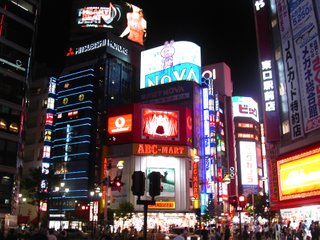 Picture of Shinjuku courtesy of Fuji Film staff
Picture of Shinjuku courtesy of Fuji Film staff"It is the most popular amusement center and one of the largest night-cities in the world. Here are bars--thousands of them--cabarets, clubs, restaurants, theatres, coffee shops, a whole city within a city served by the most crowede railway station in the whole country. Here too is the most spectacularaspect of modern Tokyo...." --Intoducing Japan, Donald Richie
"If you had only a day in Tokyo and wanted to dive headfirst into the modern Japanese phenomenon, Shinjuku would be the place to go. Nearly everything that makes Tokyo interesting rubs elbows here:high-class department stores, discount shopping arcades, flashing neon, government offices, swarming push-and-shove crowds, street-side video screens, stand-up noodle bars, hostess clubs, tucked-awayshrines and sleazy strip bars."--Japan, Lonely Planet
Shinjuku`s East Side
Just wandering around the area is interesting. If you exit the East Exit of Shinjuku Station you will find department stores, camera shops, and more. Kabuki-cho, the most infamous red-light district of Japan is east of Seibu Shinjuku Station and North of Yasukuni Street. The range of "adult" entertainment is mind boggling. In mostplaces, tourists from outside of Japan are not permitted entry, but it is still interesting to visit the area.You can also find movie theatres and some good restaurants and bars around.
Shibuya (Yamamote Line)
A youth oriented area known for entertainment, restaurants, movie theatres, bars, night clubs and shopping. It is usually extremely crowded and tourists can often be seen photographing the large intersection near the Hachiko Exit(Hachiko is the statue of a famous dog) of Shibuya Station, as the sight of thousands of people crossing the street is very interesting, especially if you come from Spud City, Idaho!
Shibuya is an area that has Love Hotels. The unique hotels, couples here often use for ashort time, if you know what I mean, nudge, nudge... You can seem some of the gaudy yetinteresting architecture of some of the hotels North of Shibuya Station up the hill.Take the Hachiko exit and head North. Tokyo National Museum
Thursday, November 23, 2006
Meiji Shrine & Harajuku
 Photo by Norikazu Yamaguchi
Photo by Norikazu Yamaguchi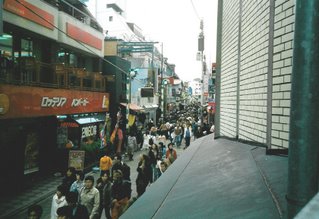
Photo of Tokyo street scene by Fuji Film staffers
"Meiji-jingu is probably the finest shrine in Japan and well worth a visit."--Ian McQueen
Meiji Jingu -- Meiji Shrine & Harajuku
Indeed the quietest section of the whole city and one of the most traditional is Meiji Shrine.It is a Shinto shrine within a cypress forest. The entrance to the shrine is near Harajuku Station on the Yamanote Line and Meiji-jingu-mae Station on the Chiyoda Line. You can catch the Yamanote Line from Tokyo, Shinjuku, Shibuya, or Ueno Stations.
The shrine was built in honor of Emperor Meiji, who is famous for modernizing Japan. On New Year`s Day over 1 million people come to Meiji Shrine to pay their respects and enjoy the gardens and quiet. After visiting Meiji take a stroll down Omote Sando, the main street of the Harajuku area.
Near Meiji-Jingu is Harajuku, the most European area of Tokyo, with broad lanes filled with leafy trees and interesting European inspired architecture. Shops range the gamut from fashion, antiques,toys to hobbies. Many great restaurants are in the area too. Along with Shibuya, Harajukuis also one of the most popular areas for young Japanese.
The Cos-Play Zoku
Show off their wacky outfits and Gothic stylemake-up at Harajuku`s Jingu Bridge area. Manyof these girls are bullied at school and thisis their way of expressing themselves, and getting away from it all on the weekends. It is worth a look to see yet another side of Japan, the one they don`t show in the government approved tourist books.
Sometimes there are interesting flea markets too in the area.
Imperial Palace, Ginza, Ebisu, Odaiba, Roppongi & Disneyland
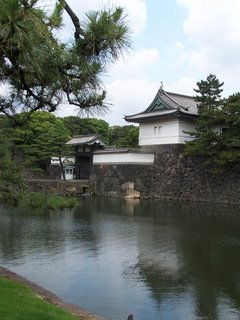
 Photos of Imperial Palace courtesy of Fuji Film Staffers
Photos of Imperial Palace courtesy of Fuji Film StaffersThe Imperial Palace
"The Imperial Palace, formerly Edo Castle, is still surrounded by its original innermost moat. Handsome gates and old guard towers are set at intervals around the grounds. The main entrance is approached by the elegant Nijubashi or Double Bridge and is open to the public on special occasions. The East Garden (Higashi Gyoen) is where the original donjon once stood. The garden is graced with flowers and blossoms..."--Japan National Tourist Organization
*To get there:By train: Hibiya Stations of the Chiyoda, Mita and Hibiya subway lines, Nijubashimae Station of the Chiyoda line, Otemachi Station--Mita line, Tokyo Station-Marunouchi line, and Yurakucho station of the Yamonte and Keihin-Tohoku line.
If leaving from the TIC (Tokyo International Centre),turn left and go a couple of hundred metres to the moat that you will see to the right. Find the road that crosses the moat and this leads to a park.Crossing Nijubashi (Niju Bridge) allows you to see inside the Imperial Palace grounds. Higashi Gyoen or East Garden is just a little north and is open until 3PM on most days. It is an attractive Japanese garden. A nice walk can be had by strolling along the moat. In the spring this is one of the most beautiful places in Japan, with the cherry blossoms in full bloom.
Ginza
Just a ten minute walk takes you to Ginza district, one of the most famous shopping areas of the world. "It is still the place to go and be seen emptying the contents of a bulging wallet. Even if you are on a tight budget, Ginza is aninteresting area in which to browse--the galleries are usually free and there are lots of discount coffee shops." --Japan, Lonely Planet There are also a few movie theatres in the area if you`dcare to see the latest movies. You can also watch Japan`s famous Kabuki theatre at Kabuku-zain Ginza. There are usually headphones available so you can hear what is going on in English whilewatching the action on stage. Kabuki-sa Tel. 03-5565-6000
Tsukiji Fish Market
"The long, cold trip to Tokyo came to an end for tuna number 197 with a thud, a bonk, and one last cavernousclunk as the huge fish toppled off the truck and skittered across the slippery concrete floor. Two, maybe threedays earlier, this torpedo-shaped bluefin had been searching for its supper in chilly waters off Boston."The Great Tokyo Fish Market Tsukiji, National Geographic Vol 188, No. 5 T.R. Reid
Tsukiji is by far the largest fish market in the world. It ranks at the top of every measurable category.You should try to get there after 7AM but before 10AM. It is an interesting place to go to watch theaction. Be careful though of the delivery carts that go speeding around the market. Ebisu (Yamanote Line)
Ebisu Station is next to Shibuya on the Yamanote Line. It is a pleasant, Western looking area and goodfor strolling around. There are some good restaurants and shops in the area. Ebisu Garden Place(Tel. 5423-7111) is very picturesque and can be reached easily from Ebisu Station. It is a romantic spot at night that is all lit up. There is a very nice French restaurant at the end of the square and the Beer Museum Yebisu which is open from 10AM-6PM and gives free admission. You can sample the various Sapporo Beers. There are manyrestaurants and cafes in Ebisu Garden Place and some are up on the 38th and 39th floors of Ebisu GardenPlace Tower. They offer excellent views of the city.
Odaiba (in Tokyo Bay)
Odaiba was built on reclaimed land and reminds me of a miniature version of English Bay in Vancouver. If youhaven`t been to English Bay in the summertime, you are missing a very beautiful and interesting part of the world.Odaiba is worth going to as well, if you are not from one of the very picturesque port cities, or if you simplywant a break from the crowds of Tokyo. Odaiba is like spending the day in Seattle or Vancouver. It has thatkind of atmosphere. It really doesn`t seem like Tokyo. To get there take the Tokyo Rinkai Shinkotsu Sen(Tokyo Waterfront New Transit Line or the Yurikamome Line). There are some very nice hotels in thisarea and it might be a nice area to stay in while you visit Tokyo. You can go into Tokyo for the day andcome back to your hotel in Odaiba to relax. There is even a white sand beach in the bay.
Fuji Television has a very interesting building in Odaiba with a large ball. You can`t miss it! You can pay a smallfee to see the view from the observatory. There are tours of Fuji TV too, but they are all in Japanese.
Decks Tokyo Beach Complex: Has many shops and restaurants. There is a movie plex too. You can saunter over to nearby Shiokaze Park and have lunch. It affords nice views of Tokyo Bay and is a romantic spot at night.
Roppongi
Roppongi is still the place to go for dancing and nighttime entertainment. You can reach Roppongi easily fromEbisu Station by taking the Hibiya Line. You can also reach it from the Toei Oedo Line. There is not muchof interest during the daytime here. Tokyo Tower (modelled on the Eiffel Tower) is not so far from Roppongi.Station.
Tokyo Disney Resort
This huge area comprises Tokyo Disneyland, Tokyo Disney Sea,the Ipskiari Shopping Center & the Official Disney Hotels that surround the two amusement parks. Palm trees are in abundance and you can be forgiven for thinking you are in Hawaii!
(Near Tokyo, in Chiba) It is open from 8:30AM-10PM in the summer and 10AM-6PM in the winter. Though smaller it is very similar to Disneyland in California. Tel. 047-354-0001. To get there take the Keiyo Line from Tokyo Station and get off at Maihama Station. It only takes about 13 minutes.
Tokyo, Asia`s Most Exciting City
 Shinjuku, a shopping and entertainment district of Tokyo
Shinjuku, a shopping and entertainment district of TokyoPhoto by Norikazu Yamaguchi
Population: 15 million
Tokyo is one of the largest cities on the planet. It vibrates with energy and vitality. One`s pulse quickens with the pace and noise of this gargantuan city. It isn`t a place to relax in. It is a shoppers paradise, a place to party or savour the food of any country of the world.
This city that never sleeps, is massive and will make most cities seem small in comparison. Yet it is a city that is surprisingly easy to get around once you know how the train lines run. Indeed it is a city that works, and city planners the world over really should study her.
There is little of historical sightseeing interest in this huge megalopolis, but there are areas that are worth exploring: Harajuku for the European flavour and youthful exuberance of the area,Asakusa for the historical feel, & Roppongi for the nightlife; Akihabara, Ginza, Shinjuku and Shibuya for shopping, and Odaiba for the modernity and beauty of the area. If you are interested in museums you should go to Ueno.
Travel writer Ian L. McQueen suggests: "For a quick introduction to the city, a long-recommendedand still valid suggestion is to ride the Yamanote loop (Yamanote Train Line-ed) for one circuit of the city, a trip of about an hour. This will show how so much of the city is made up of low (one or two-storey) houses interspersed with taller apartment and commercial buildings. Since the line passes through most of the major sub-city areas, it also gives a view of the tremendous amount of development that has taken place in these clusters."
You can pick up free maps of Tokyo at the TIC--Tokyo International Centre. TIC: Tokyo International Centre
Monday, November 20, 2006
Beautiful Nikko!

Nikko, the Gem North of Tokyo
"Nikko well deserves to be one of the most popular day trips from Tokyo, but to beat the crowds, consider turning it into a three day trip; spend a night, see Nikko in the early morning, then push on into the interior of Nikko National Park,to a region of wild mountains and onsen lodges." --June Kinoshita & Nicholas Palevsky, Gateway to Japan
"Nikko, 2 hrs. by rail from Tokyo, is both a gem of natural beauty and home to one of the must-sees of Japanese architecture. Toshogu Shrine which houses the mausoleum of the founderof the Tokugawa shogunate, is Nikko`s most famous attraction. The complex is unusual among Japanese architectural gems for its display of opulence and decorative complexity."--JNTO, Japan National Tourist Organization, Your Guide to Japan
Nikko
How to Get There?
(2hrs from Tobu-Asakusa Station via and express train on the Tobu-Nikko Line. Or you can take aTohoku Shinkansen (bullet train) from Tokyo or Ueno Station to Utsunomiya Station 45-50 min., then change to the JR Nikko line for the last part of the journey, which takes 45 minutes)
I have been to Nikko many times now and the temples and the detail on them always amazes me. It really is one of the must see places in Japan.
What to see?
Shinkyo Bridge
Is about 1 km from Tobu-Nikko Station or Nikko Station. Built in 1636. There is a legend about the bridge in which two enormous serpents carried Shodo Shonin across it.
Rinno-ji (Founded 1,200 Years ago!)
In this Tendai temple, is housed three gilt images of Amida Nyorai, a thousand armed Kannon, and a Kannon with a horse`s head. This is Buddhist exhibition of the three gods of Futara. Inside the Homotsuden are many treasures worth seeing.
ikko Tosho-gu
A huge gate greets you as you enter this Shinto shrine. On the left you will see a five story pagoda that was originally built in 1650 but had to be reconstructed in 1818. (Typical of so many of Japan`s wooden buildings, destroyed by fire, floods, earthquakes, and typhoons). The Omote Gate is protected by DevaKings. Go straight and you will see the Three Sacred Storehouses. On the second floor of the last storehouse you can see carvings of elephants by a carver who had never seen one. In the Shinkyusha (to the left) you will see a carved white horse. Inside the stable you can see the life cycle of the monkey; "the hear no evil,see no evil, speak no evil," which has come to epitomize Nikko. In the sacred library are 7,000 Buddhist scrolls and books. Unfortunately, it isn`t open to the public.
As you go through another gate you will see a drum tower and a belfry. On the left of the tower is the Honji-do which has a large ceiling painting of a dragon in flight. A monk may bang two wooden sticks togetherto show you the strange echo of this hall. It is supposed to sound like the roar of a dragon.
Yomei Gate is atypical of Japanese architecture with its preponderance of detail, which includes: animals, real and mythological, as well as gold leaf and red laquer. It is truly beautiful so be sure to bring your camera! Detail is everywhere with depictions of Chinese sages, dancing women and flowers to name a few. Somehave suggested the shrine is more Chinese than Japanese. Others have worried that the perfection was too much and might enrage the Gods. To prevent this, one pillar was deliberately built upside down. See if you can find it.
On the right of Yomei Gate is the sleepy cat, which is famous in Japan for its realistic appearance. Go through Sakashita Gate and follow the path through the trees to Ieyasu`s tomb. Ieyasu is famous for uniting Japan.
Furarasan-Shrine (Jinja) Founded in 782 Is basicly a smaller version of Toshu-gu but well worth seeing as well. The demon lantern or (bake-torii) still has the sword markings left by a samurai.
aiyuin-byo
Is a mausoleum dedicated to Ieyasu`s grandson who was the powerful third shogun Iemitsu.This was built in 1653. It is as beautiful as Toshu-gu but in a more picturesque setting in a lush forest. Well worth a visit! "While the Toshu-gu is dazzling and overpowering, the Taiyuin-byo is considered morebalanced and esthetically superior. The ornately carved Nio Gate marks the entrance. To the left are sacred storehouses similar to those at Tosho-gu."--June Kinoshita & Nicholas Palevsky, Gateway to Japan
Kegon Falls -- one of Nikko`s most famous attractions
Take the elevator that actually goes down through the cliff to a spectacular observation deck. You can also view Futara-san Shrine on the lakeshore.
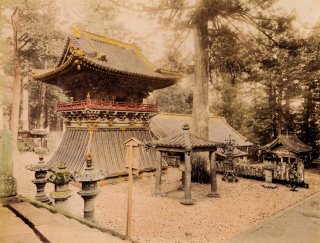 Some vintage pictures of Nikko
Some vintage pictures of Nikko
Saturday, November 04, 2006
The Greenlist of English Schools in Japan

Many teachers worry about choosing the wrong school to work for. Hopefully our Greenlist can help! If you know of a good school in Japan or work for one, tell us about the school here. If possible include a link to it in your post and put it in the links section as well. While there are many bad schools in Japan, there are also many great schools to work for. Indeed there are many great employers who genuinely care about their students and teachers. If they didn`t, they would go out of business!
Visit the Greenlist of English Schools in Japan
Subscribe to:
Posts (Atom)